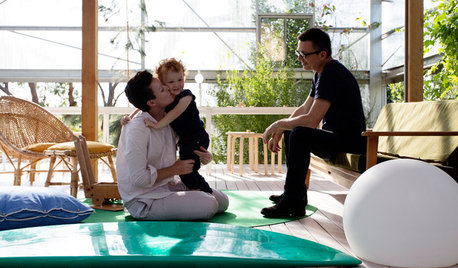Dead grass and bare spots plus weeds
UrbanMythx
11 years ago
Related Stories

GARDENING GUIDESHow to Fix Bare and Yellow Lawn Spots
Restore your turf’s good looks by reseeding unsightly patches
Full Story
EDIBLE GARDENSNatural Ways to Get Rid of Weeds in Your Garden
Use these techniques to help prevent the spread of weeds and to learn about your soil
Full Story
GARDENING GUIDES5 Ways to Naturally Win the Weed War
Show irksome weeds no mercy with these tricks for combating them sans chemicals
Full Story
HOMES AROUND THE WORLDWorld of Design: A House That’s Barely There
A rural Australian home blurs the boundaries between indoors and outdoors, camping and permanence, privacy and transparency
Full Story
GARDENING GUIDESGreat Design Plant: Bugle Weed, a Quick Ground Cover
It’s highly adaptable, suppresses weeds, reduces erosion and provide weeks of bright flowers. Just watch for invasiveness
Full Story
GARDENING GUIDES5 Weed-Smothering Ground Covers
Let these landscape plants do the dirty work of choking out weeds while you sit back and enjoy the view
Full Story
GARDENING GUIDESWhat’s in a Name? See 6 Wildflowers That Aren’t ‘Weeds’ at All
Dispel the stereotypes of weeds and try these wildlife-supporting native wildflowers in your garden
Full Story
HOUZZ TOURSHouzz Tour: From Overgrown Weeds to Picturesque Farmhouse Expanse
This once-neglected 100-acre South Carolina site now features a lake, a wood-filled farmhouse and a far-reaching view
Full Story
LANDSCAPE DESIGNIs It Time to Consider Fake Grass?
With more realistic-looking options than ever, synthetic turf can be a boon. Find the benefits and an installation how-to here
Full Story
CENTRAL PLAINS NATIVE PLANTS10 Top Grasses for the Central Plains
Low-maintenance grasses provide seasonal interest and wildlife habitat, and aid good design
Full StoryMore Discussions







dchall_san_antonio
reyesuela
Related Professionals
Wrentham Landscape Architects & Landscape Designers · Birmingham Landscape Architects & Landscape Designers · Ilchester Landscape Architects & Landscape Designers · West Chester Landscape Architects & Landscape Designers · Wake Forest Landscape Contractors · Caldwell Landscape Contractors · Davidson Landscape Contractors · Holland Landscape Contractors · Huntley Landscape Contractors · Kaysville Landscape Contractors · Lake Zurich Landscape Contractors · Riverview Landscape Contractors · Soddy Daisy Landscape Contractors · Sugar Hill Landscape Contractors · Sun City Center Landscape ContractorsUrbanMythxOriginal Author
dchall_san_antonio
UrbanMythxOriginal Author